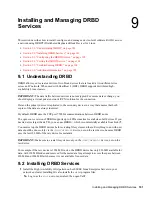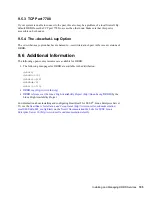
98
SLES 10 Storage Administration Guide
no
vd
ocx
(e
n)
6 Ap
ril 20
07
mount -t reiserfs /dev/md0 /mnt/point
5
Check the effect of the resize on the mounted file system by entering
df -h
The Disk Free (
df
) command shows the total size of the disk, the number of blocks used, and
the number of blocks available on the file system. The -h option print sizes in human-readable
format, such as 1K, 234M, or 2G.
8.3.2 Decreasing the Size of Component Partitions
Resize the RAID’s component partitions one at a time. For each component partition, you remove it
from the RAID, modify its partition size, return the partition to the RAID, then wait until the RAID
stabilizes. While a partition is removed, the RAID operates in degraded mode and has no or reduced
disk fault tolerance. Even for RAIDs that can tolerate multiple concurrent disk failures, you should
never remove more than one component partition at a time.
WARNING:
If a RAID does not have disk fault tolerance, or it is simply not consistent, data loss
results if you remove any of its partitions. Be very careful when removing partitions, and make sure
that you have a backup of your data available.
The procedure in this section uses the device names shown in the following table. Make sure to
modify the commands to use the names of your own devices.
Table 8-4
Scenario for Increasing the Size of Component Partitions
To resize the component partitions for the RAID:
1
Open a terminal console, then log in as the
root
user or equivalent.
2
Make sure that the RAID array is consistent and synchronized by entering
cat /proc/mdstat
If your RAID array is still synchronizing according to the output of this command, you must
wait until synchronization is complete before continuing.
3
Remove one of the component partitions from the RAID array. For example, to remove
/dev/
sda1
, enter
mdadm /dev/md0 --fail /dev/sda1 --remove /dev/sda1
In order to succeed, both the fail and remove actions must be done.
4
Increase the size of the partition that you removed in
Step 3
by doing one of the following:
Use a disk partitioner such as
fdisk
,
cfdisk
, or
parted
to increase the size of the
partition.
Replace the disk on which the partition resides with a different device.
RAID Device
Component Partitions
/dev/md0
/dev/sda1
/dev/sdb1
/dev/sdc1
Summary of Contents for LINUX ENTERPRISE SERVER 10 - STORAGE ADMINISTRATION GUIDE 7-2007
Page 4: ...novdocx en 6 April 2007...
Page 30: ...30 SLES 10 Storage Administration Guide novdocx en 6 April 2007...
Page 42: ...42 SLES 10 Storage Administration Guide novdocx en 6 April 2007...
Page 58: ...58 SLES 10 Storage Administration Guide novdocx en 6 April 2007...
Page 90: ...90 SLES 10 Storage Administration Guide novdocx en 6 April 2007...
Page 100: ...100 SLES 10 Storage Administration Guide novdocx en 6 April 2007...
Page 106: ...106 SLES 10 Storage Administration Guide novdocx en 6 April 2007...

























